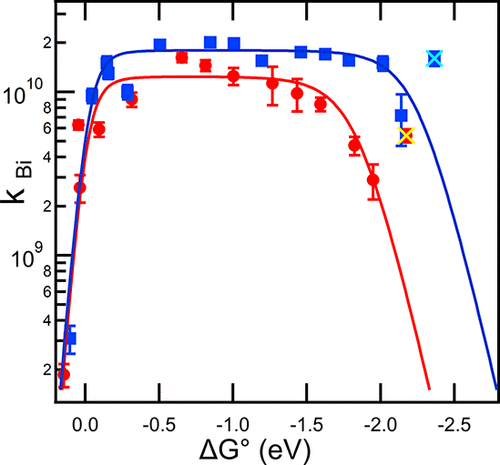当前位置:
X-MOL 学术
›
J. Am. Chem. Soc.
›
论文详情
Our official English website, www.x-mol.net, welcomes your feedback! (Note: you will need to create a separate account there.)
The Inverted Region in Bimolecular Electron Transfer in Solution Enabled by Delocalization
Journal of the American Chemical Society ( IF 15.0 ) Pub Date : 2020-09-29 , DOI: 10.1021/jacs.0c04780 Norihiko Takeda 1 , John R. Miller 1
Journal of the American Chemical Society ( IF 15.0 ) Pub Date : 2020-09-29 , DOI: 10.1021/jacs.0c04780 Norihiko Takeda 1 , John R. Miller 1
Affiliation

|
Rate constants for bimolecular electron transfer (ET) increased with driving force, -G°, reached a plateau, and then decreased in an inverted region. This rate data was described well by electron transfer theory subject to a diffusion-controlled limit. These were for ET from radical anions of polydecylthiophene (P3DT) to a series of acceptors in THF solution. When the donor was the smaller anion of quaterthiophene (T4•-) the inverted region was much less prominent, and still less so for when the donor was the anion of bithiophene (T2•-). Description of the data using ET theory identifies smaller electronic couplings for the highly-delocalized P3DT anions as enabling the inverted behavior: The presence of a Marcus inverted region is a consequence of delocalized electronic states. The results further imply that electronic couplings smaller than usually found for molecules in contact could boost efficiency of energy storage by electron transfer, and identifies size-mismatch as an important concept in control of electronic couplings.
中文翻译:

离域化使溶液中双分子电子转移的反转区域
双分子电子转移(ET)的速率常数随着驱动力的增加而增加,-G°,达到一个平台,然后在一个倒置的区域中减少。受扩散控制限制的电子转移理论很好地描述了该速率数据。这些是从聚癸基噻吩 (P3DT) 的自由基阴离子到 THF 溶液中的一系列受体的 ET。当供体是四噻吩(T4•-)的较小阴离子时,倒置区域不那么突出,当供体是联噻吩(T2•-)阴离子时更不明显。使用 ET 理论对数据的描述将高度离域 P3DT 阴离子的较小电子耦合确定为能够实现反转行为:马库斯反转区域的存在是离域电子态的结果。
更新日期:2020-09-29
中文翻译:

离域化使溶液中双分子电子转移的反转区域
双分子电子转移(ET)的速率常数随着驱动力的增加而增加,-G°,达到一个平台,然后在一个倒置的区域中减少。受扩散控制限制的电子转移理论很好地描述了该速率数据。这些是从聚癸基噻吩 (P3DT) 的自由基阴离子到 THF 溶液中的一系列受体的 ET。当供体是四噻吩(T4•-)的较小阴离子时,倒置区域不那么突出,当供体是联噻吩(T2•-)阴离子时更不明显。使用 ET 理论对数据的描述将高度离域 P3DT 阴离子的较小电子耦合确定为能够实现反转行为:马库斯反转区域的存在是离域电子态的结果。

























 京公网安备 11010802027423号
京公网安备 11010802027423号